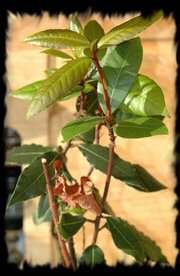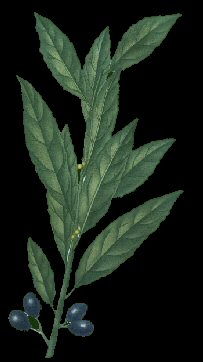|
|

K i t c h e n
With its roots buried deep in Greek Mythology, Apollo`s Bay is the source of the well-known culinary herb `The Bay Leaf`.
Common names: Bay Laurel, Bay Leaf, Sweet Bay, Bay, Sweet Laurel.
Scientific name: Laurus nobilis
Laurus - the ancient name for this plant: Nobilis - Latin for noble or famous. 
While in the olden days, conquerors and poets, of heroic or poetic fame, wore wreaths of laurel leaves, today it is one of the most sought after culinary spices for flavouring soups, casseroles, stews, fish, meat, and marinades.
Laurus nobilis, the original true laurel is the source of bay leaves used as a seasoning,
On the left: "Laurus nobilis" (the "Nobel Laurel") © 2006 MorgueFile, used by permission.
The thick and shiny green leaves are hand picked then laid out in the shade to dry, a process, that, when done correctly, intensifies the flavour of the leaf. Any exposure to direct sunlight will cause the leaves to turn brown, and to loose most of their oil essential for the cooking process. It is also helpful to weigh the leaves down whilst drying to overcome the problem of leaf curl. They retain their pungency for a considerable period, and store well in jars.
Bay leaves have a delicate, and slightly aromatic scent, and add a mildly bitter yet strong flavour to food. The large dried leaves are one of the oldest herbs used in cookery. None of the laurel leaves are used when fresh. 
The only other use, except spice, is the oil, which is rare and very little used in cooking. The olive, which often replaced the laurel for wreaths, produces a much more popular oil - the virgin olive oil.
Bay can be made into an oil which, when rubbed into the affected area, can help to relieve the symptoms of arthritic aches and pains, muscle sprains, lower back pain and tendon swellings. To make the oil, simply heat some of the leaves in a little olive oil over very low heat for approximately 20 minutes without actually cooking the oil too much or causing it to burn and smoke. Set aside and allow the leaves to simmer for a while, strain, and use the oil as needed.
• Top•
Above: "Cherry Laurel" (Picture © Missuri Botanic garden, used by permission) which is often called "laurel in gardens", is an evergreen cherry, Prunus Laurocerasus. There are a several kinds of the bay leaf. Many people believe that the "ordinary" laurel can cure many ailments, but one variety, the "Laurel Cherry" is dangerously poisonous. It looks slightly different, as shown on the left side. 
The Cherry Laurel is exceptional in having green shoots, and the yellowish-green tint of its leathery evergreen leaves is characteristic of this variety. They somewhat resemble those of the Orange or of the Magnolia.
On the right: "Sweet Laurel" (picture © Missuri Botanic garden, used by permission).
Bay has a settling effect on the human digestive system settling the stomach and acting to stimulate the appetite and assist in the secretion of digestive juices. When added as an ingredient in cooking, bay laurel leaves aid in the digestion and absorption of food. The leaves have a similar effect to spearmint and rosemary in assisting the breakdown of heavy food, especially meat.
This herb is no longer worshiped at it has been thousands of years ago. Could the Greek scholars have known how their Holy laurel would one day be casually used in flavour food?

|

